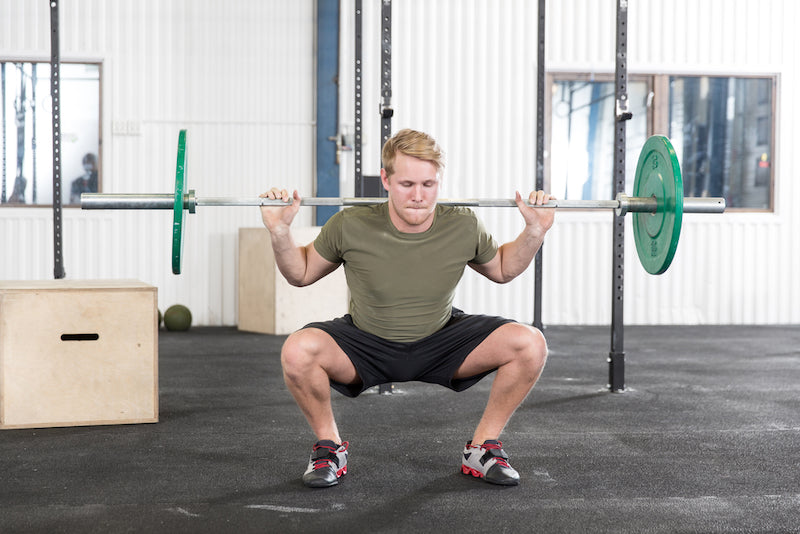By understanding the connection between the hip hinge and squat movements, you can enhance your overall leg strength, improve your lifting techniques, and prevent injuries.
Let's dive in.
The Hip Hinge and Squat Connection
Building strong and stable lower body muscles requires mastery of the hip hinge and squat patterns.
The hip hinge focuses on pushing the hips back while maintaining a relatively straighter knee, engaging the glutes and hamstrings.
The squat pattern, on the other hand, involves a more significant knee bend and vertical torso, targeting the quadriceps.
Comprehending the differences between these two movement patterns, including the unique movement pattern of each, allows for a more targeted lower body workout.
The Role of Hip Hinge in Squats

When you hinge at the hips before squatting, you engage and strengthen the posterior chain muscles, such as the glutes, hamstrings, and lower back.
This engagement helps distribute the weight evenly across your lower body, allowing for a more effective workout and reduced risk of injury.
Beyond injury prevention, adding a hip hinge to your squats can also lead to better performance.
Emphasizing movement in the knee joint and overloading your hamstrings results in stronger, more mobile hips, glutes, and hamstrings. This translates to more power and improved squat patterns.
The Role of Squats in Hip Hinge Training
Apart from enhancing your quads, squats also contribute significantly to hip hinge training.
By activating your glutes and providing knee stability during squats, you can master the hip hinge technique more effectively. This, in turn, can lead to improved performance and decreased risk of injury.
Mastering the Hip Hinge Technique
To perform hip hinge movements optimally, focus on drawing a short string between your belly button and the bottom of your ribs, keeping your ribs down and preventing arching in your lower back.
Additionally, it’s essential to make sure that you send your hips back before you gently bend your knees.
Mastering the hip hinge technique allows you to optimize power and strength by moving the weight with your hips and hamstrings, instead of your lower back.
The hip hinge is essential for a range of exercises, such as:
-
Kettlebell swings
-
Good mornings
-
Deadlifts
-
Hip thrusts
-
Squats
These exercises target the posterior chain muscles and improve overall lower body strength.
Creating Full Body Tension
Creating full body tension effectively engages the whole body during movements like the hip hinge. To achieve this, follow these steps:
-
Brace your core by contracting your abdominal muscles as if you were preparing to be punched in the stomach.
-
Activate your glutes by squeezing your buttocks together.
-
Focus on driving your feet into the ground to create a stable base.
-
Squeeze your shoulder blades together to engage your upper back muscles.
By following these steps, you can maintain proper form and activate all the muscles necessary for optimal performance.
For optimal form and muscle activation, make sure to:
-
Keep your spine in a neutral position
-
Engage your core throughout the movement
-
Keep your knees in line with your toes
-
Resist the urge to let your hips rise too quickly or fall forward
Maintaining full body tension guarantees proper form, helps prevent injuries, and optimizes the benefits of your hip hinge exercises.
Balancing Knee Flexion and Hip Extension

Achieving proper squat form requires a balance between knee flexion and hip extension, something the integration of hip hinge techniques can facilitate.
By emphasizing the movement and activation of the hip muscles, hip hinge techniques can help you achieve a balance between knee flexion and hip extension in the squat, distributing the load evenly between the knees and hips.
This reduces strain on the knees and improves hip mobility and stability, allowing for a smoother and more controlled squat movement.
Low-intensity squat exercises at slow speeds, barbell back squats, and straight leg raises are great exercises to help you achieve better balance between knee flexion and hip extension in squats.
Activating Glutes and Hamstrings
In addition to activating the glutes and hamstrings, incorporating hip hinge techniques into your squat exercises can also lead to improved core stability and posture.
By focusing on proper form and alignment, you can reduce the risk of injury and achieve a more effective and efficient squat movement, allowing you to reach your full lower body strength potential.
Common Mistakes and How to Avoid Them
Recognizing and rectifying common errors in squat and hip hinge movements substantially aids in injury prevention and performance improvement. Some typical mistakes to watch out for include:
-
Reaching with the arms instead of the butt
-
Lack of knee bend or excessive knee bend
-
Rounding the shoulders
-
Bending at the knees before the hips
-
Inward collapsing knees and ankles
-
Duck butt posture
Additionally, it is important to make sure you are flexing the hips rather than externally rotating them.
Awareness of these common mistakes and proactive correction allow for the development of a more effective and efficient squat and hip hinge technique.
This not only helps you avoid injury but also maximizes your performance and overall leg strength.
Overloading the Knees
Overloading the knees in squats and hip hinge exercises may result in injury and impede your progress. To stop squatting with excessive stress on the knees, follow these tips:
-
Maintain proper form and technique by keeping your hips tall and driving your chest toward the floor during a hip hinge.
-
Pay close attention to your foot placement and keep your weight in your heels.
-
Ensure your knees are aligned over your toes.
By following these guidelines, you can protect your knees and continue making progress in your workouts.
Adhering to these tips ensures effective force distribution between the knees and hips, promoting safety during your lower body workouts. This will not only protect your knees but also allow you to get the most out of your hip hinge and squat exercises.
Neglecting Core Stability
Maintaining core stability during squat and hip hinge movements is key to preserving proper form and mitigating injury risk. Neglecting core stability can have a detrimental effect on your squat and hip hinge technique, leading to increased stress on the lumbar spine and a heightened risk of injury.
To maintain core stability during these movements, keep your spine in a neutral position and engage your core throughout the exercise. By focusing on core stability, you can ensure proper alignment and control during your squat and hip hinge exercises, allowing for efficient force transfer and minimizing the risk of injury.

Summary
In conclusion, understanding the connection between the hip hinge and squat movements and incorporating these techniques into your training routine can significantly enhance your overall leg strength, improve your lifting techniques, and prevent injuries.
By mastering the hip hinge technique, focusing on full body tension and posterior chain engagement, and incorporating various squat and hip hinge variations into your workouts, you can unlock your full lower body strength potential.













